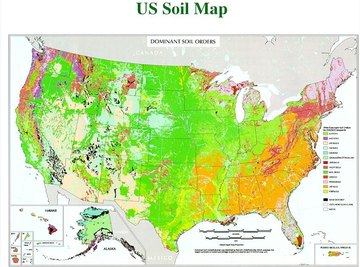
Alaska is described as having Tanana earth. This term is typically used to describe an area where the soil is poorly drained and contains permafrost less than 5 feet below the surface of the soil. Alaskan soil is made up of silt, sand and gravel. The soil make-up is largely due to erosion caused by glacial ice, permafrost, and frozen rivers.
Soil Orders
Soil is classified into groups, or orders, based on its properties. The properties of soil refer to its texture, moisture content, organic content, and pH level. There are twelve soil orders: entisols, gelisols, histolsols, vertisols, andisols, inceptisols, ardisols, mollisols, alfisols, ultisols, spodosols, and oxisols.
The Majority of Alaska
Gelisols describes the majority of soil in the Alaskan tundra. Gelisols are typically found in high latitude polar regions. Gelisols are divided into three subcategories. Histel gelisols contain large amounts of organic matter. Turbel gelisols are produced as a result of mixing by frost action. Orthel gelisols are the most common and are soils that do not meet the criteria for histel or turbel gelisols.
Other Soil Orders Found in Alaska
Alaska is the most diverse state when it comes to soil types, containing seven of the twelve soil orders. Andisols are also found in Alaska and are a result of volcanic ash deposits. New soil with little development, or entisols, are another soil order of Alaska. Other soil orders found in Alaska are histosols, inceptisols, mollisols, and spodosols.
Plant Life in Alaska
The properties of the soil order determine the types of ecosystems which can be supported in that region. If the soil is too cold or does not get the proper nutrients, water or light, the vegetation will not thrive. If the vegetation cannot thrive, the ecosystem is likely to be effected.
Considerations
The soil in Alaska tends to be higher in organic matter, meaning it contains more nutrients. It also contains less toxins and contaminants compared to soil in more industrialized states. But the vegetation must be able to survive the poor drainage of the soil and withstand the cold temperatures of the tundra.
References
Resources
About the Author
Amanda Ballard Coates is a Certified Professional Coder (CPC) and a member of the American Association of Professional Coders. She is also a freelance writer and photographer. She writes mostly nonfiction and has been published on several informative websites. Ballard Coates' writing has been published on websites such as Healthmad.com, Quazen.com, Gomestic.com and Socyberty.com.
Photo Credits
University of Minnesota Academics
